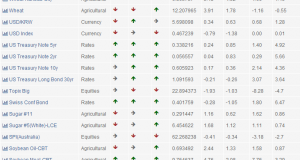Supposedly there are no exploitable market anomalies since they would all have been destroyed by hedgers the instant they appeared. Well, that is at least what many text books would claim but if you are working in this business you already know better. One of the most oddly persistent anomalies and therefore one of the more interesting trade situations for the past ten years or so has been the natural gas. Being short the natural gas futures has been a hugely profitable trade year in and year out and there are no indications that anything has changed in that regards.
The spot price of natural gas has not changed terribly much over the years although there has been bull and bear phases as well as the occasional price shock. The price at the start of 2000 was about 2.2 and the current spot is about 2.5, so no big difference. Trading the spot is not only impractical, but also quite meaningless for our type of strategy as there is no clear long term trend in the spot price. The future is a completely different story though and while the spot price has moved up about 10% since January of 2000, the future has fallen by 90%. No, that is not a typo.
The reason that this massive difference is possible is the sharp and persistent contango situation in this commodity. If you read this site and have an interest in futures trading you are likely already aware of the meaning of contango and its implications. In short, a commodity is said to be in contango when the price is higher farther out in the future than nearer to the present. It can be visualized by plotting the prices of each successive futures contract delivery month in a chart and if the line slopes upwards, you have a state of contango, as opposed to backwardation should it slope downwards.
 For a commodity to be in contango is quite normal and for good reasons. If you agree to sell a commodity two months from now at a fixed price, you normally want to be paid a little more than it costs to buy it today. This has nothing to do with expected price change in that time, but rather with hedging costs. To offset your position risk, you would need to borrow money today at interest, buy the commodity in the spot market and then pay for storage etc. until it’s time to deliver. This last part is where natural gas futures become so interesting. Storing natural gas is extremely expensive and while I’ll avoid boring you with the finer points of massive underground gas storage facilities, I think you can see why it is not a simple matter of putting the gas in your back yard for a couple of months. Since the storage cost is so high, the price will always be much higher far out in the future, and as those contracts approach maturity, they will slowly drop down to match the spot price by the time they go to delivery. Therefore you get a long term downward trend in your futures contracts. As long as storage costs are so high, there is very little reason to be long this very peculiar commodity.
For a commodity to be in contango is quite normal and for good reasons. If you agree to sell a commodity two months from now at a fixed price, you normally want to be paid a little more than it costs to buy it today. This has nothing to do with expected price change in that time, but rather with hedging costs. To offset your position risk, you would need to borrow money today at interest, buy the commodity in the spot market and then pay for storage etc. until it’s time to deliver. This last part is where natural gas futures become so interesting. Storing natural gas is extremely expensive and while I’ll avoid boring you with the finer points of massive underground gas storage facilities, I think you can see why it is not a simple matter of putting the gas in your back yard for a couple of months. Since the storage cost is so high, the price will always be much higher far out in the future, and as those contracts approach maturity, they will slowly drop down to match the spot price by the time they go to delivery. Therefore you get a long term downward trend in your futures contracts. As long as storage costs are so high, there is very little reason to be long this very peculiar commodity.
Last week was a very odd week even for this special animal. We got stopped out of a very profitable short position when the volatility suddenly saw a massive expansion to the downside. From an already very strong downward trend, the nat gas futures started dropping at a parabolic rate. This may be fun to watch when you are on the right side of the trade, but these volatility expansions are generally bad for our strategy as this instance shows. As the price drops hard, our stops move much closer and when the inevitable rebound comes we get stopped out and lose our position very fast. Still, there is every reason to believe that we will get another short signal soon enough and be back in the trade again.
The current Diversified Futures Trading portfolio is still in a seemingly conflicting trade, heavily long both bonds and equities. The long dollar bet is being gradually reduced and at the moment that is just a minor side theme. The double long of equities and rates is certainly good for diversification purposes but one of them is likely to turn out right while the other is likely to be stopped out soon enough.
| Market | Direction | Sector | Entry Date |
|---|---|---|---|
| Coffee | Short | Agricultural Commodities | 2011-12-13 |
| Cattle-Live | Long | Agricultural Commodities | 2012-01-25 |
| Hogs-Lean(Floor Trading Only) | Short | Agricultural Commodities | 2012-01-12 |
| Oats | Short | Agricultural Commodities | 2012-01-13 |
| Orange Juice-Frozen | Long | Agricultural Commodities | 2012-01-23 |
| Rice-Rough | Short | Agricultural Commodities | 2011-11-10 |
| Sugar #11 | Short | Agricultural Commodities | 2011-11-25 |
| Australian Dollar | Long | Currencies | 2012-01-18 |
| British Pound | Short | Currencies | 2011-12-30 |
| New Zealand Dollar | Long | Currencies | 2012-01-26 |
| Dax Index | Long | Equities | 2012-01-27 |
| FTSE 100 Index | Long | Equities | 2012-01-11 |
| Nasdaq 100 Index | Long | Equities | 2012-01-19 |
| S&P 500 | Long | Equities | 2012-01-11 |
| Crude Oil-Light | Long | Non-Agricultural Commodities | 2012-01-04 |
| Gasoline-Reformulated Blendstock | Long | Non-Agricultural Commodities | 2012-01-19 |
| Canadian Bankers' Acceptance-3Mth-ME (24 hr) | Short | Rates | 2012-01-03 |
| Canadian Govt Bond 10Yr | Long | Rates | 2011-11-24 |
| Euro German Bund | Long | Rates | 2012-01-10 |
| Euro German Bobl | Long | Rates | 2011-12-15 |
| Euro German Schatz | Long | Rates | 2011-11-10 |
| Eurodollar-3 Mth | Long | Rates | 2012-01-26 |
| EURIBOR-3 Mth | Long | Rates | 2012-01-23 |
| Euro Swiss Franc | Short | Rates | 2012-01-23 |
| Gilt-Long(8.75-13yr) | Long | Rates | 2011-11-16 |
| T-Note-U.S. 5 Yr | Long | Rates | 2011-12-08 |
| Japanese 10yr Govt Bond | Long | Rates | 2012-01-12 |
| T-Note-U.S. 2 Yr | Long | Rates | 2011-12-08 |
The performance has been disappointing the past few months but bear in mind that these periods are the cost of doing business in the managed futures field. You will often have long periods of slowly losing money but in the past 30 years, they have always been followed by strong gains which make up for the bad periods. The worse things go, the higher the likelihood of a nearing recovery. Stick with the strategy, stick with the rules.
 Following the Trend
Following the Trend






